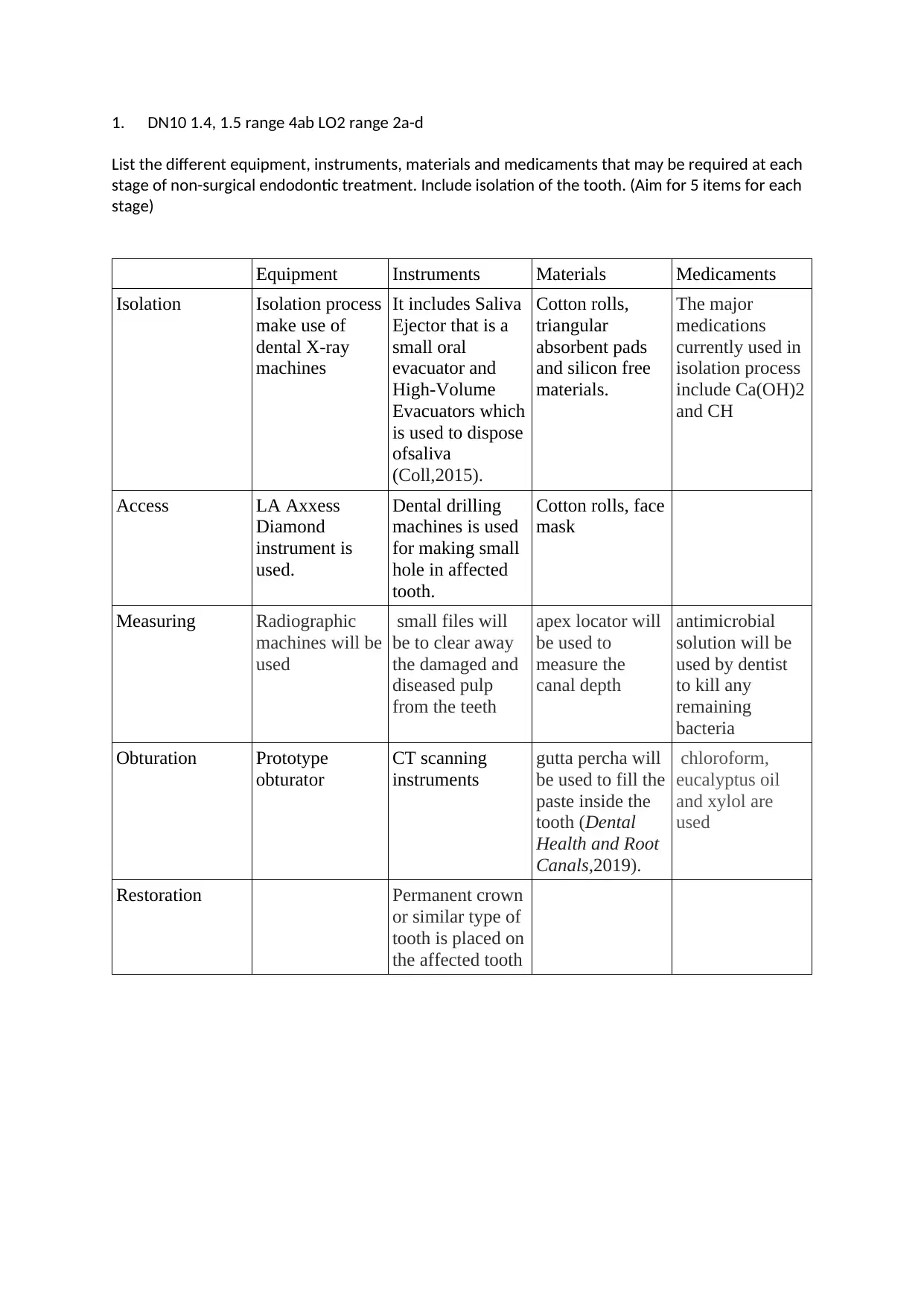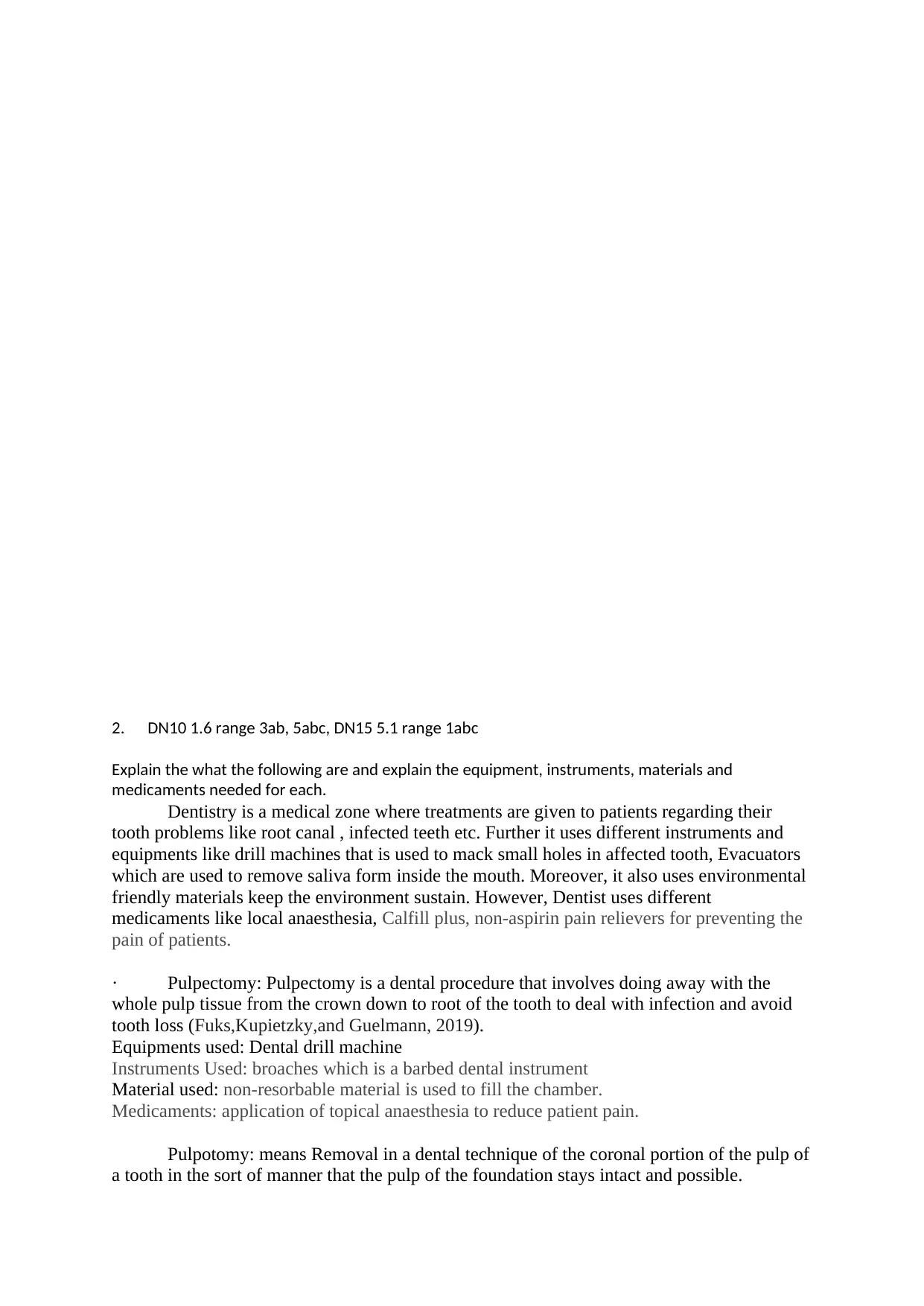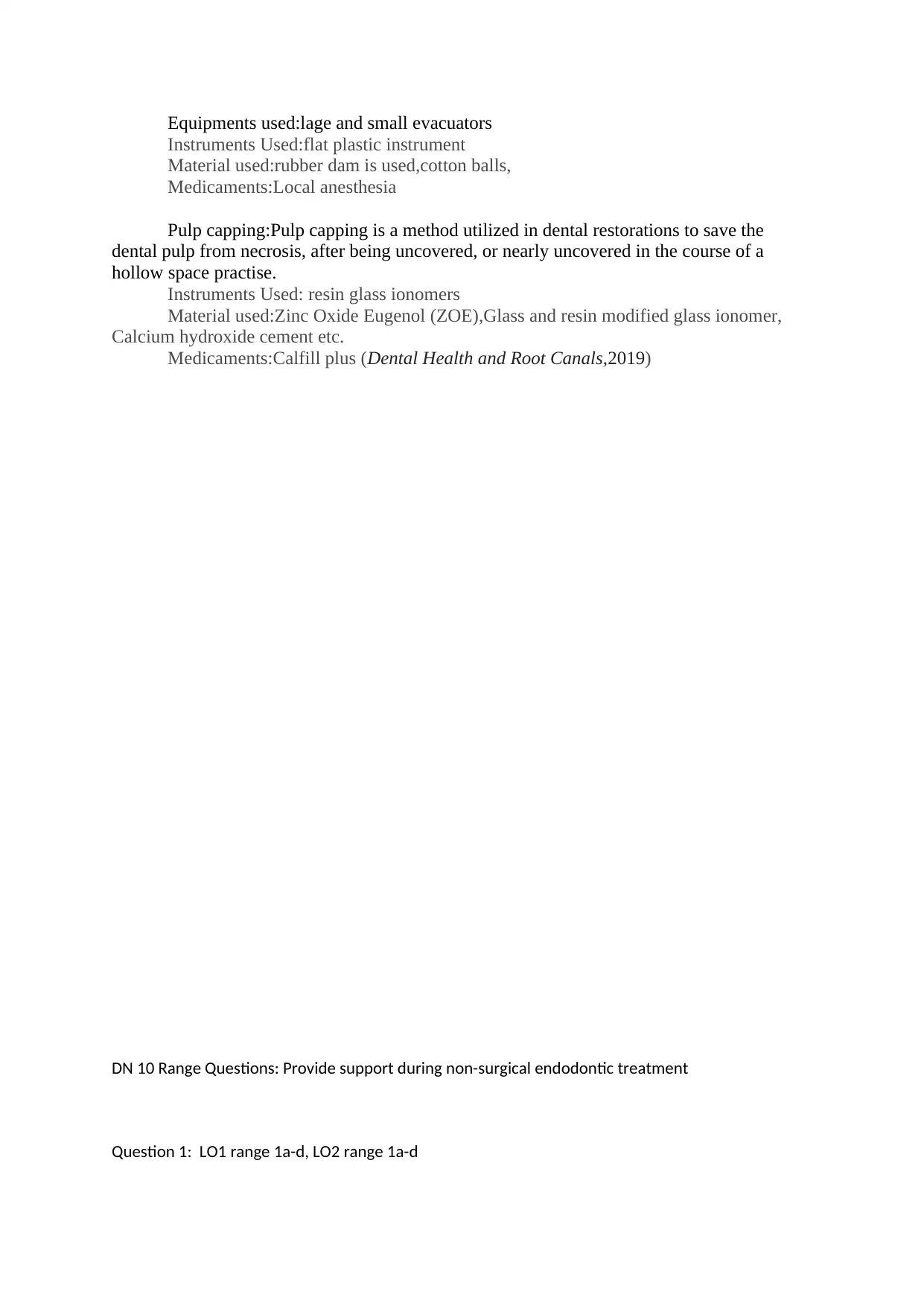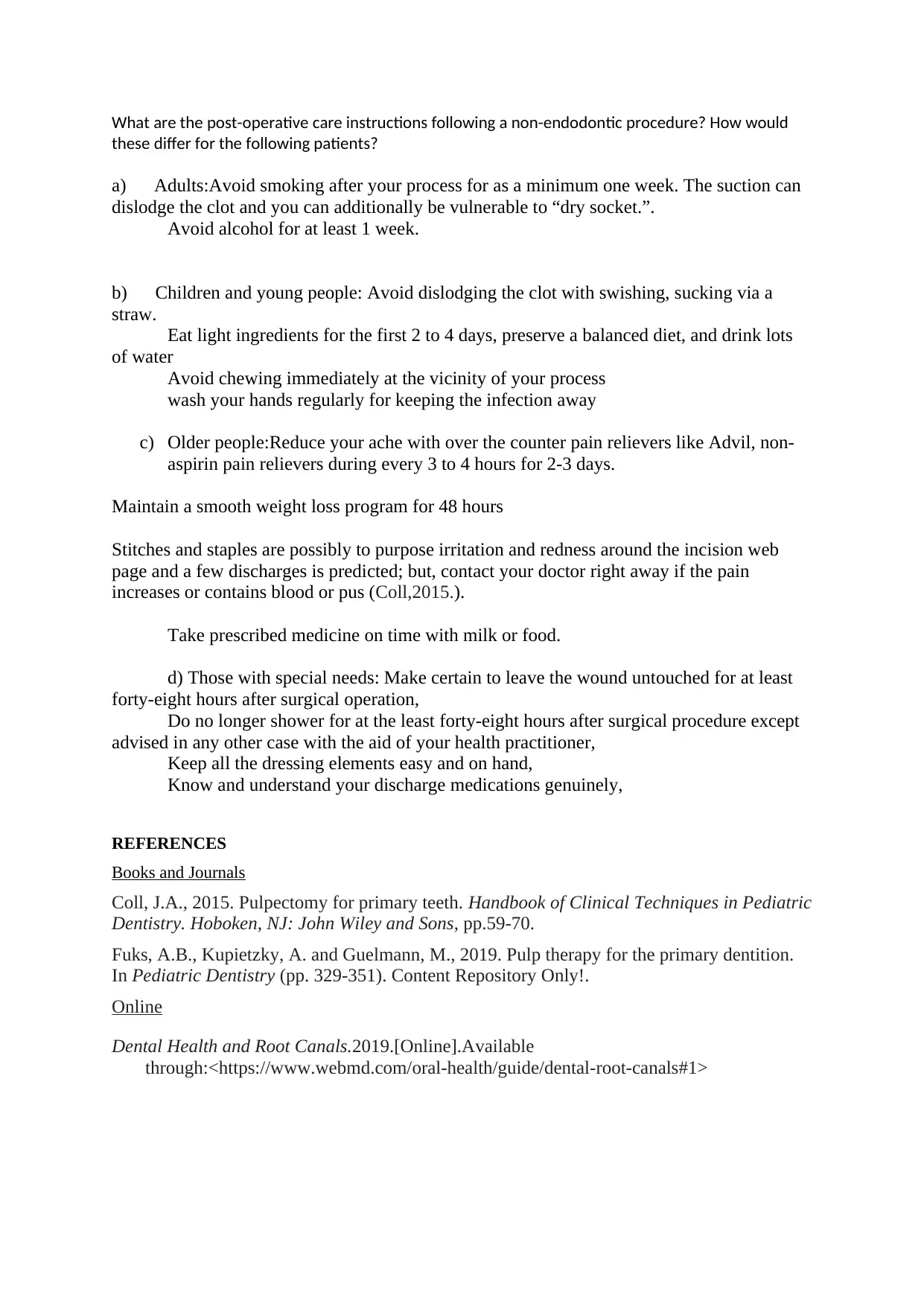DN10: Endodontic Treatment Stages, Post-Op Care, Patient Instructions
VerifiedAdded on 2020/11/23
|4
|1124
|398
Homework Assignment
AI Summary
This assignment provides a comprehensive analysis of non-surgical endodontic treatment, covering the equipment, instruments, materials, and medicaments required at each stage, including isolation, access, measuring, and obturation, as well as restoration. It also explains pulpectomy, pulpotomy, and pulp capping procedures, detailing the necessary equipment, instruments, materials, and medicaments for each. Furthermore, the assignment addresses post-operative care instructions for adults, children, older people, and individuals with special needs, providing specific guidelines to ensure optimal patient outcomes. The provided references include books and journals related to the subject, supporting the information presented in the assignment.

1. DN10 1.4, 1.5 range 4ab LO2 range 2a-d
List the different equipment, instruments, materials and medicaments that may be required at each
stage of non-surgical endodontic treatment. Include isolation of the tooth. (Aim for 5 items for each
stage)
Equipment Instruments Materials Medicaments
Isolation Isolation process
make use of
dental X-ray
machines
It includes Saliva
Ejector that is a
small oral
evacuator and
High-Volume
Evacuators which
is used to dispose
ofsaliva
(Coll,2015).
Cotton rolls,
triangular
absorbent pads
and silicon free
materials.
The major
medications
currently used in
isolation process
include Ca(OH)2
and CH
Access LA Axxess
Diamond
instrument is
used.
Dental drilling
machines is used
for making small
hole in affected
tooth.
Cotton rolls, face
mask
Measuring Radiographic
machines will be
used
small files will
be to clear away
the damaged and
diseased pulp
from the teeth
apex locator will
be used to
measure the
canal depth
antimicrobial
solution will be
used by dentist
to kill any
remaining
bacteria
Obturation Prototype
obturator
CT scanning
instruments
gutta percha will
be used to fill the
paste inside the
tooth (Dental
Health and Root
Canals,2019).
chloroform,
eucalyptus oil
and xylol are
used
Restoration Permanent crown
or similar type of
tooth is placed on
the affected tooth
List the different equipment, instruments, materials and medicaments that may be required at each
stage of non-surgical endodontic treatment. Include isolation of the tooth. (Aim for 5 items for each
stage)
Equipment Instruments Materials Medicaments
Isolation Isolation process
make use of
dental X-ray
machines
It includes Saliva
Ejector that is a
small oral
evacuator and
High-Volume
Evacuators which
is used to dispose
ofsaliva
(Coll,2015).
Cotton rolls,
triangular
absorbent pads
and silicon free
materials.
The major
medications
currently used in
isolation process
include Ca(OH)2
and CH
Access LA Axxess
Diamond
instrument is
used.
Dental drilling
machines is used
for making small
hole in affected
tooth.
Cotton rolls, face
mask
Measuring Radiographic
machines will be
used
small files will
be to clear away
the damaged and
diseased pulp
from the teeth
apex locator will
be used to
measure the
canal depth
antimicrobial
solution will be
used by dentist
to kill any
remaining
bacteria
Obturation Prototype
obturator
CT scanning
instruments
gutta percha will
be used to fill the
paste inside the
tooth (Dental
Health and Root
Canals,2019).
chloroform,
eucalyptus oil
and xylol are
used
Restoration Permanent crown
or similar type of
tooth is placed on
the affected tooth
Paraphrase This Document
Need a fresh take? Get an instant paraphrase of this document with our AI Paraphraser

2. DN10 1.6 range 3ab, 5abc, DN15 5.1 range 1abc
Explain the what the following are and explain the equipment, instruments, materials and
medicaments needed for each.
Dentistry is a medical zone where treatments are given to patients regarding their
tooth problems like root canal , infected teeth etc. Further it uses different instruments and
equipments like drill machines that is used to mack small holes in affected tooth, Evacuators
which are used to remove saliva form inside the mouth. Moreover, it also uses environmental
friendly materials keep the environment sustain. However, Dentist uses different
medicaments like local anaesthesia, Calfill plus, non-aspirin pain relievers for preventing the
pain of patients.
· Pulpectomy: Pulpectomy is a dental procedure that involves doing away with the
whole pulp tissue from the crown down to root of the tooth to deal with infection and avoid
tooth loss (Fuks,Kupietzky,and Guelmann, 2019).
Equipments used: Dental drill machine
Instruments Used: broaches which is a barbed dental instrument
Material used: non-resorbable material is used to fill the chamber.
Medicaments: application of topical anaesthesia to reduce patient pain.
Pulpotomy: means Removal in a dental technique of the coronal portion of the pulp of
a tooth in the sort of manner that the pulp of the foundation stays intact and possible.
Explain the what the following are and explain the equipment, instruments, materials and
medicaments needed for each.
Dentistry is a medical zone where treatments are given to patients regarding their
tooth problems like root canal , infected teeth etc. Further it uses different instruments and
equipments like drill machines that is used to mack small holes in affected tooth, Evacuators
which are used to remove saliva form inside the mouth. Moreover, it also uses environmental
friendly materials keep the environment sustain. However, Dentist uses different
medicaments like local anaesthesia, Calfill plus, non-aspirin pain relievers for preventing the
pain of patients.
· Pulpectomy: Pulpectomy is a dental procedure that involves doing away with the
whole pulp tissue from the crown down to root of the tooth to deal with infection and avoid
tooth loss (Fuks,Kupietzky,and Guelmann, 2019).
Equipments used: Dental drill machine
Instruments Used: broaches which is a barbed dental instrument
Material used: non-resorbable material is used to fill the chamber.
Medicaments: application of topical anaesthesia to reduce patient pain.
Pulpotomy: means Removal in a dental technique of the coronal portion of the pulp of
a tooth in the sort of manner that the pulp of the foundation stays intact and possible.

Equipments used:lage and small evacuators
Instruments Used:flat plastic instrument
Material used:rubber dam is used,cotton balls,
Medicaments:Local anesthesia
Pulp capping:Pulp capping is a method utilized in dental restorations to save the
dental pulp from necrosis, after being uncovered, or nearly uncovered in the course of a
hollow space practise.
Instruments Used: resin glass ionomers
Material used:Zinc Oxide Eugenol (ZOE),Glass and resin modified glass ionomer,
Calcium hydroxide cement etc.
Medicaments:Calfill plus (Dental Health and Root Canals,2019)
DN 10 Range Questions: Provide support during non-surgical endodontic treatment
Question 1: LO1 range 1a-d, LO2 range 1a-d
Instruments Used:flat plastic instrument
Material used:rubber dam is used,cotton balls,
Medicaments:Local anesthesia
Pulp capping:Pulp capping is a method utilized in dental restorations to save the
dental pulp from necrosis, after being uncovered, or nearly uncovered in the course of a
hollow space practise.
Instruments Used: resin glass ionomers
Material used:Zinc Oxide Eugenol (ZOE),Glass and resin modified glass ionomer,
Calcium hydroxide cement etc.
Medicaments:Calfill plus (Dental Health and Root Canals,2019)
DN 10 Range Questions: Provide support during non-surgical endodontic treatment
Question 1: LO1 range 1a-d, LO2 range 1a-d
⊘ This is a preview!⊘
Do you want full access?
Subscribe today to unlock all pages.

Trusted by 1+ million students worldwide

What are the post-operative care instructions following a non-endodontic procedure? How would
these differ for the following patients?
a) Adults:Avoid smoking after your process for as a minimum one week. The suction can
dislodge the clot and you can additionally be vulnerable to “dry socket.”.
Avoid alcohol for at least 1 week.
b) Children and young people: Avoid dislodging the clot with swishing, sucking via a
straw.
Eat light ingredients for the first 2 to 4 days, preserve a balanced diet, and drink lots
of water
Avoid chewing immediately at the vicinity of your process
wash your hands regularly for keeping the infection away
c) Older people:Reduce your ache with over the counter pain relievers like Advil, non-
aspirin pain relievers during every 3 to 4 hours for 2-3 days.
Maintain a smooth weight loss program for 48 hours
Stitches and staples are possibly to purpose irritation and redness around the incision web
page and a few discharges is predicted; but, contact your doctor right away if the pain
increases or contains blood or pus (Coll,2015.).
Take prescribed medicine on time with milk or food.
d) Those with special needs: Make certain to leave the wound untouched for at least
forty-eight hours after surgical operation,
Do no longer shower for at the least forty-eight hours after surgical procedure except
advised in any other case with the aid of your health practitioner,
Keep all the dressing elements easy and on hand,
Know and understand your discharge medications genuinely,
REFERENCES
Books and Journals
Coll, J.A., 2015. Pulpectomy for primary teeth. Handbook of Clinical Techniques in Pediatric
Dentistry. Hoboken, NJ: John Wiley and Sons, pp.59-70.
Fuks, A.B., Kupietzky, A. and Guelmann, M., 2019. Pulp therapy for the primary dentition.
In Pediatric Dentistry (pp. 329-351). Content Repository Only!.
Online
Dental Health and Root Canals.2019.[Online].Available
through:<https://www.webmd.com/oral-health/guide/dental-root-canals#1>
these differ for the following patients?
a) Adults:Avoid smoking after your process for as a minimum one week. The suction can
dislodge the clot and you can additionally be vulnerable to “dry socket.”.
Avoid alcohol for at least 1 week.
b) Children and young people: Avoid dislodging the clot with swishing, sucking via a
straw.
Eat light ingredients for the first 2 to 4 days, preserve a balanced diet, and drink lots
of water
Avoid chewing immediately at the vicinity of your process
wash your hands regularly for keeping the infection away
c) Older people:Reduce your ache with over the counter pain relievers like Advil, non-
aspirin pain relievers during every 3 to 4 hours for 2-3 days.
Maintain a smooth weight loss program for 48 hours
Stitches and staples are possibly to purpose irritation and redness around the incision web
page and a few discharges is predicted; but, contact your doctor right away if the pain
increases or contains blood or pus (Coll,2015.).
Take prescribed medicine on time with milk or food.
d) Those with special needs: Make certain to leave the wound untouched for at least
forty-eight hours after surgical operation,
Do no longer shower for at the least forty-eight hours after surgical procedure except
advised in any other case with the aid of your health practitioner,
Keep all the dressing elements easy and on hand,
Know and understand your discharge medications genuinely,
REFERENCES
Books and Journals
Coll, J.A., 2015. Pulpectomy for primary teeth. Handbook of Clinical Techniques in Pediatric
Dentistry. Hoboken, NJ: John Wiley and Sons, pp.59-70.
Fuks, A.B., Kupietzky, A. and Guelmann, M., 2019. Pulp therapy for the primary dentition.
In Pediatric Dentistry (pp. 329-351). Content Repository Only!.
Online
Dental Health and Root Canals.2019.[Online].Available
through:<https://www.webmd.com/oral-health/guide/dental-root-canals#1>
1 out of 4
Your All-in-One AI-Powered Toolkit for Academic Success.
+13062052269
info@desklib.com
Available 24*7 on WhatsApp / Email
![[object Object]](/_next/static/media/star-bottom.7253800d.svg)
Unlock your academic potential
Copyright © 2020–2025 A2Z Services. All Rights Reserved. Developed and managed by ZUCOL.


